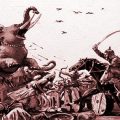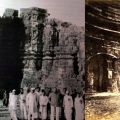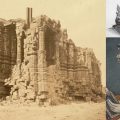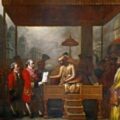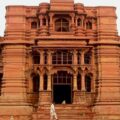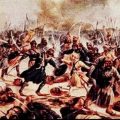How Rich was India? An Account Through Loot by Mahmud of Ghazni
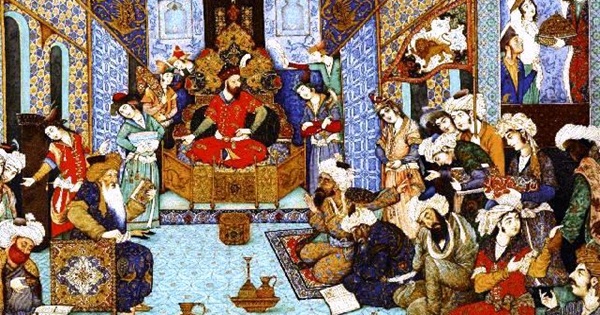
Aryavart! Bharat!! India!!! There is a huge difference between all three terminologies that describe our nation. Gone were the days when India was the richest country in the world. Home to the oldest civilization, she abounded in glory in every sphere, from wealth to wisdom, from advanced technology to art. She was home to the world’s oldest universities – the Takshashila, dating back to Mahabharata period and Nalanda from Gupta era. India’s significant achievements in science, medicine, surgery, mathematics, literature, philosophy, astrology, astronomy, architecture are well described in the Vedas, Puranas, and other ancient scriptures. Said al-Andalusi, an Arab Muslim judge and historian from the 11th century wrote about India in his book Ṭabaqāt al-ʼUmam – ‘The Indians, as known to all nations for many centuries, are the metal (essence) of wisdom, the source of fairness and objectivity. They are peoples of sublime pensiveness, universal apologue…’
The existing glory and riches started declining with Islamic invasion and plunder and later by the British. And Aryavart or Bharat became India. While few plunderers repeatedly raided and plundered India, looting wealth, destroying temples and forts, killing innocents besides burning and pillaging entire towns and villages, they took along with them lakhs of Hindu women as sex slaves every time they came. One of the biggest loot and plunder of India was conducted by Sultan Mahmud of Ghazni. With the wealth looted from India, Mahmud turned Ghazna that covered Pakistan, eastern Iran, and parts of Afghanistan into a wealthy empire. Every household, as described by Persian historian Firishta, was abundantly rich with several slaves (captives taken from India, especially women).
Firishta, through the eyes of Sultan Mahmud of Ghazni, has described numerous Indian cities as grand. While many of these cities were destroyed, few were left with little pillage against a handsome regular annual tribute by the rulers. Few grand cities worth mentioning are Mathura, Thaneshwar, Kannauj, Delhi, Mahuvan, Somnath, and the list goes on. About Mathura, Sultan Mahmud wrote a letter to his governor that no one could build a city as grand as Mathura even in a time period of 200 years involving millions of dinars, that it was next to impossible to build a similar one. The reader can well imagine how beautiful and grand Mathura was 1000 years ago!

About Kannauj, Firishta wrote, “a city which raised its head to the skies, and which in strength and beauty might boast of being unrivalled.”

Why couldn’t Indian rulers defend their territories or safeguard their people from the plunderers? The fighting spirit in Indian warriors started declining after the concept of non-violence gained momentum. Most Indian kings and their subjects lost interest in warfare. Generation after generation, the courage, fearlessness, and valor which otherwise were the key attributes of warriors and soldiers, started to decline. Few Indian rulers gave little importance in maintaining a robust army or upgradation of military infrastructure. Hence, they were taken unawares when Islamic invaders attacked their kingdoms.
Moreover, Indian rulers strictly followed rules of Dharma in warfare. They avoided fighting with an opponent already engaged in a fight with another. They avoided stabbing from behind or hitting below the navel. They took care of the injured at the end of the day. They considered women, prisoners of war, and farmers as sacred. They never pillaged the land or destroyed standing structures in enemy lands. They were merciful if enemies asked for pardon. Battlefield exploits took place only during daytime. This was followed since time immemorial. History is full of such examples of Dharma followed by Indian Hindu kings. Sultan Mahmud of Ghazni, Mohammad Ghori, Taimur and other Islamic plunderers did exactly the opposite of these rules of Dharma followed by Indians. And they mostly attacked the kingdoms unexpectedly at odd hours.
Majority of the Indian rulers did offer stiff resistance to Sultan Mahmud. For example the ruler of Bhera (mentioned as Bhateea by Firishta) in Punjab, Raja Vijay Rai (Beejy Ray by Firishta) tortured the Mohammedan governors that Sultan Mahmud left behind for collection of tribute during his earlier raids. He was a vassal of Anandpal, the Raja of Lahore. As a vassal, he was supposed to pay tribute to Anandpal, but he claimed sovereignty. When Sultan Mahmud attacked Bhera in 1004 CE, Raja Vijay Rai offered stiff resistance.

The Bhera Fort was ‘fortified with an exceedingly high wall, and surrounded by a deep and broad ditch.’ A fierce battle took place between the two parties. For three days the battle continued during which the Mohammedan forces ‘suffered so much that they were on the point of abandoning their enterprize.’ It was on the fourth day that they could move till the gates of the fort. But they could not enter the fort. For several days, they laid siege at the base as the ditch surrounding the fort prohibited their further attempts. Sultan Mahmud then entrusted his men to fill the ditch. And Bhera fell in the Sultan’s hands.

In the words of Firishta, “Two hundred and eighty elephants, many slaves, and other spoils, were obtained in the town; which Mahmood annexed, with its dependencies, to his own dominions, and returned victorious to Ghizny.” Likewise, two princes Brahma Dev and Dhabishleem of Gujarat engaged in battle with Sultan Mahmud for several days in an attempt to save Somnath temple, but the barbaric and clever tactics of the Ghaznavid plunderer gave way. Thousands of Hindus attained martyrdom while trying to save Somnath.
Those rulers who kept a ready army and upgraded their military infrastructure survived the attacks. They offered a stiff resistance. Many rulers defeated the barbaric Islamic invaders and plunderers and many regions remained untouched. But all of the sagas of valor and victory of the Indian warriors are not highlighted in our history books. Few victories worth mentioning are Kashmir king Lalitaditya Muktapida against Arabs led by Junaid, north and south Indian alliance led by Gurjar Pratihar king Nagbhat I against Arabs, Raja Samgramaraja of Kashmir against Sultan Mahmud of Ghazni, Naiki Devi of Gujarat against Mohammad Ghori, Raja Prithu of Assam against Bakhtiyar Khilji, confederation of Hindus led by Jograj Singh Gurjar and Rampyari Gurjar against Taimur, Rani Karnavati of Grahwal against Shah Jahan’s Mughal forces, Rani Bhavashankari of Bengal against Pathans, Narasimhadeva of Orissa against Bengal Sultanate, Kapaya Nayaka of Warangal against Turks, Baba Banda Singh Bahadur against various Islamic forces in Punjab, Rani Chennamma of Keladi against Aurangzeb’s forces, and the list goes on and on. Moreover, the fact that Hindus are still in majority despite frequent attacks by Islamic plunderers for several centuries corroborates that majority stuck to beliefs and traditions despite tortures.
Firishta’s book History of the Rise of the Mohammedan Power in India (screenshot extracts of the book included in this article), translated by John Briggs gives a detailed account of Sultan Mahmud’s raids of the Indian kingdoms. But this book does not contain complete details of his raids. Firishta either purposefully or unconsciously omitted details of few expeditions. He does mention about Sultan Mahmud’s failed Kashmir expedition, but does not describe details. According to several sources, Sultan Mahmud of Ghazni attacked and plundered India, especially northern, central and western parts 17 times. He did not touch south. But the loot, plunder, and destruction were so huge that India not only lost a treasure house of ancient archaeological evidences and wealth amounting to trillions but also saw a huge reduction of Hindu population. Firishta in his book has described Sultan Mahmud terming the Hindu population as ‘infidels’. Describing every loot of an Indian kingdom by Sultan Mahmud would lead to extended length of the article beyond capacity. Hence, I shall be delving on counted few major incidents that will well throw light on how extremely rich India was and how she was drained of her resources by the barbaric plunderer.
Amongst the earliest Hindu rulers to be subjugated was Raja Jaipal of Lahore. Jaipal offered a stiff resistance, but could not match the cruel tactics employed by Mahmud. He was let free against payment of an annual tribute. It was 1001 CE. Besides the tribute that amounted to lakhs of dinars, Sultan Mahmud took away sixteen necklaces inlaid with jewels from Jaipal. One of these precious necklaces belonged to Jaipal. It was valued at 180,000 dinars in 1001 CE. One dinar is equivalent to an amount of Rs. 231 at present. Imagine the value of Jaipal’s necklace, going by today’s time!

In 1009 CE, Sultan Mahmud of Ghazni attacked Nagarkot (Kangra valley of Himachal Pradesh). He plundered the city, razing the temples to the ground and breaking the idols. They destroyed Bheem Fort, setting it on fire after killing the inhabitants and looting wealth. The fort, located atop a steep mountain, served as the treasury for many neighboring kingdoms. Money and gold donated by devotees in temples of the region and neighboring kingdoms were stored at this fort. In the words of Firishta, “Bheem was built by a prince of the same name, on the top of a steep mountain, where the Hindoos, on account of its strength, had deposited the wealth consecrated to their idols by all the neighbouring kingdoms; so that in this fort there is supposed to have been a greater quantity of gold, silver, precious stones, and pearls, than was ever collected in the royal treasury of any prince on earth.” The attack of the fort by Sultan Mahmud was so sudden and unexpected that the Hindus could not defend the fort.
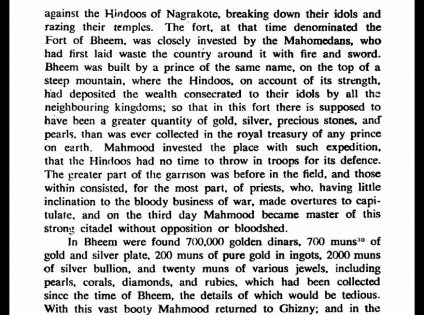
Regarding the wealth looted from Bheem Fort, Firishta wrote, “In Bheem were found 700,000 golden dinars, 700 muns* of gold and silver plate, 200 muns of pure gold in ingots, 2000 muns of silver bullion, and twenty muns of various jewels, including pearls, corals, diamonds, and rubies, which had been collected since the time of Bheem, details of which would be tedious.”
Such was the vastness of the booty that upon return to Ghazni, Sultan Mahmud arranged a magnificent festival to commemorate his success in looting wealth from India. At the festival, he displayed to the people of Ghazni the vast wealth in golden thrones. The gold and ornaments studded with precious jewels were piled up in a plain area for display. To every officer of the Ghaznavid Empire, Sultan Mahmud conferred a princely gift from the looted wealth!
Secular and left leaning historians including those influenced by Maoist philosophy will never tell you how Islamic plunderers not only looted wealth but also took the Hindu gentry, especially women, as captives, whom they employed as slaves.

On his Thaneshwar expedition, Sultan Mahmud took two lakh Hindus to Ghazni and made them slaves. Every soldier of Ghazni became wealthy with riches and each household keeping several slaves. Ghazni, because of the slaves and the riches, looked like an Indian city! To quote Firishta, “On this occasion, the Mahomedan army brought to Ghizny 200,000 captives, and much wealth, so that the capital appeared like an Indian city, no soldier of the camp being without wealth, or without many slaves.”

So you have heard about the loot and plunder of Mathura by Sultan Mahmud of Ghazni! But have you ever read the intensity of destruction in Mathura by this barbaric plunderer? Mathura was then under the ruler of Delhi, who could not defend the holy city of the Hindus. It took 20 days for Sultan Mahmud to destroy Mathura completely. He broke down all the idols he came across and destroyed temples. He took to Ghazni all the wealth accumulated in the temples including gold and silver idols and precious stones studded in the idols. Besides killing the innocents, he set the city on fire. Few temples destroyed near Mathura were 4000 years old, which in today’s date would have been 5000 years old! He also destroyed 7 forts in/near Mathura. Firishta in his book described Mathura as Mutra.
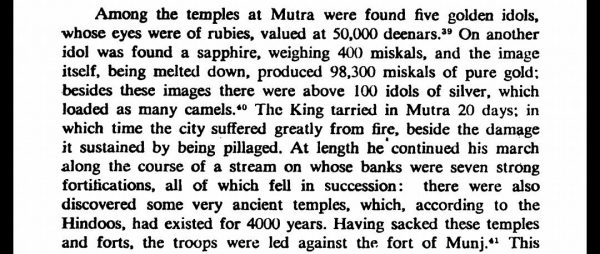
In the words of Firishta, “Among the temples at Mutra were found five golden idols, whose eyes were of rubies, valued at 50,000 deenars. On another idol was found a sapphire, weighing 400 miskals, and the image itself, being melted down, produced 98,300 miskals of pure gold ; besides these images there were above 100 idols of silver, which loaded as many camels. The King tarried in Mutra 20 days ; in which time the city suffered greatly from fire, beside the damage it sustained by being pillaged. At length he continued his march along the course of a stream on whose banks were seven strong fortifications, all of which fell in succession : there were also discovered some very ancient temples, which, according to the Hindoos, had existed for 4000 years. Having sacked these temples and forts, the troops were led against the fort of Munj.”
The rulers of Gujarat offered a stiff resistance to save Somnath temple. The battle continued for several days until Sultan Mahmud of Ghazni gained hold of the shrine. It was 1024 AD. He had heard a lot about the wealth of the temple. Do you know a group of Brahmins offered a huge donation of gold to keep the Garbhagriha, i.e. idol of Somnath untouched? While the Sultan’s men agreed and even tried to convince their master, the Sultan disagreed. He gave a reason.
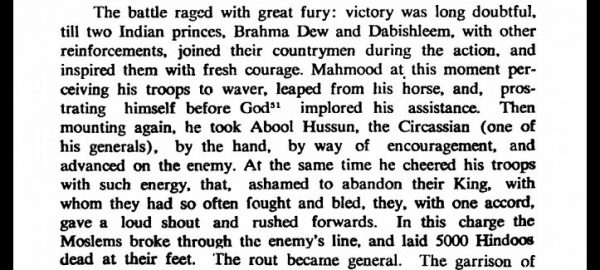
To quote Firishta, “if he should consent to such a measure, his name would be handed down to posterity as ‘Mahmood the idol-seller’ whereas he was desirous of being known as ‘Mahmood the destroyer’ he therefore directed the troops to proceed in their work.”
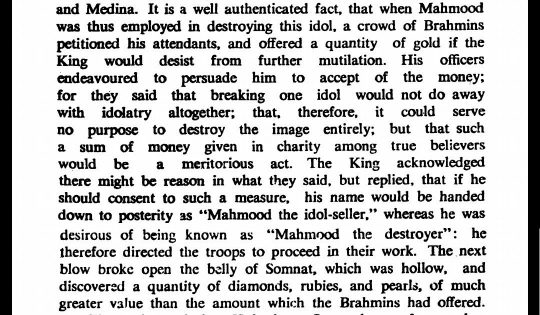
Here is a description of Somnath temple in the words of Firishta. Sultan Mahmud “saw a superb edifice built of hewn stone. Its lofty roof was supported by fifty-six pillars curiously carved and set with precious stones. In the centre of the hall was Somnat, a stone idol, five yards in height, two of which were sunk in the ground. The King, approaching the image, raised his mace and struck of its nose. He ordered two pieces of the idol to be broken off and sent to Ghizny, that one might be thrown at the threshold of the public mosque, and the other at the court door of his own palace…. Two more fragments were reserved to be sent to Mecca and Medina.”

When Firishta wrote the book, it was past 600 years of the destruction of Somnath by Sultan Mahmud. Firishta wrote that the identical fragments of the Somnath Shivalinga were seen at Ghazni during his times!
According to Firishta, during the time of eclipses 1000 years ago, Somnath temple witnessed an average of three lakh devotees. Rulers from nearby and far-off kingdoms of Bharat donated villages the revenue of which were used to run the temple. Around 2000 villages were bestowed to the Somnath temple authorities for the maintenance of the temple. Besides, rulers and devotees regularly donated gold, ornaments, precious stones, and money. Ancient scriptures and surveys by Britishers corroborate the grant of villages by rulers for maintaining temples. Besides, temples also served as learning centres and as treasury.
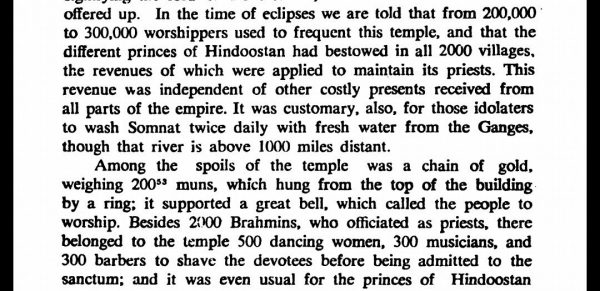
The Somnath Shivalinga was bathed twice with Ganga Jal every day. Firishta wrote, “It was customary, also, for those idolaters to wash Somnat twice daily with fresh water from the Ganges, though that river is above 1000 miles distant.” Around 2000 Brahmins served as priests in the temple. In the words of Firishta, “Besides 2000 Bramins, who officiated as priests, there belonged to the temple 500 dancing women, 300 musicians, and 300 barbers to shave the devotees before being admitted to the sanctum.”
Ancient and medieval temples of India had arrangements for lighting at night. Do you know Somnath temple had no lighting arrangements even for the night except one pendant lamp? The whole interiors of the Somnath temple were so full of jewels studded in the idols and walls that reflection of the pendant lamp on the jewels brightened the dark interiors! How gifted ancient Indians were!! To quote Firishta, “there were no lights in the temple, except one pendent lamp, which, being reflected from the jewels, spread a bright gleam over the whole edifice.” And such a precious, unique, magnificent and grand structure was destroyed and razed to the ground by Sultan Mahmud.
As per Firishta, the Somnath temple was a storehouse of vast wealth. No other royal treasury ever contained such vast wealth. Sultan Mahmud of Ghazni looted all the wealth of the temple. To quote Firishta, “Among the spoils of the temple was a chain of gold, weighing 200* muns, which hung from the top of the building by a ring; it supported a great bell, which called the people to worship. The King of Ghizny found in this temple a greater quantity of jewels and gold than it is thought any royal treasury ever contained before. Besides the great idol above mentioned, there were in the temple some thousands of small images, wrought in gold and silver, of various shapes and dimensions.”

This is an account by Persian historian where truth prevails. Firishta would not exaggerate facts though he missed giving more details about the plunderer’s raid of India. It is upon the readers to guess whether to believe or not. Firishta’s account does give an insight about India 1000 years ago. So rich and magnificent India was! The worth of wealth looted by the plunderer amounted to trillions, going by the account of the loots as well as tribute collected. Had the barbaric plunderer not plundered India then, not to mention other Islamic plunderers, India would have continued to be a self sufficient country with no signs of poverty or the various problems plaguing India at present.
Featured image courtesy: Wikipedia.
Ref
1. History of the Rise of the Mohammedan Power in India, Firishta, translated by John Briggs
2. History of Kanauj: To the Moslem Conquest, Rama S. Tripathi
3. ‘The Emergence of Muslim Rule in India: Some Historical Disconnects and Missing Links’, Islamic Studies, Tanvir Anjum.

